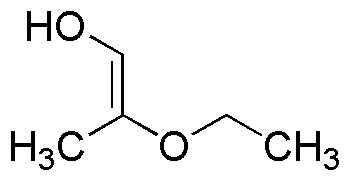Ethyl acetohydroxamate is widely utilized in research focused on various applications:
- Pharmaceutical Development: This compound serves as a key intermediate in the synthesis of various pharmaceuticals, particularly in the development of anti-cancer agents and antibiotics, enhancing their efficacy.
- Enzyme Inhibition Studies: Researchers use it to study enzyme inhibition mechanisms, especially in the context of proteases, which are crucial for understanding disease pathways.
- Agricultural Chemistry: It is applied in the formulation of agrochemicals, helping to improve the effectiveness of pesticides and herbicides, thereby increasing crop yields.
- Analytical Chemistry: Ethyl acetohydroxamate is utilized as a reagent in analytical methods, aiding in the detection and quantification of metal ions in various samples.
- Biochemical Research: The compound is valuable in biochemical assays, particularly in studying metabolic pathways and the role of hydroxamic acids in cellular processes.
General Information
Properties
Safety and Regulations
Applications
Ethyl acetohydroxamate is widely utilized in research focused on various applications:
- Pharmaceutical Development: This compound serves as a key intermediate in the synthesis of various pharmaceuticals, particularly in the development of anti-cancer agents and antibiotics, enhancing their efficacy.
- Enzyme Inhibition Studies: Researchers use it to study enzyme inhibition mechanisms, especially in the context of proteases, which are crucial for understanding disease pathways.
- Agricultural Chemistry: It is applied in the formulation of agrochemicals, helping to improve the effectiveness of pesticides and herbicides, thereby increasing crop yields.
- Analytical Chemistry: Ethyl acetohydroxamate is utilized as a reagent in analytical methods, aiding in the detection and quantification of metal ions in various samples.
- Biochemical Research: The compound is valuable in biochemical assays, particularly in studying metabolic pathways and the role of hydroxamic acids in cellular processes.
Documents
Safety Data Sheets (SDS)
The SDS provides comprehensive safety information on handling, storage, and disposal of the product.
Product Specification (PS)
The PS provides a comprehensive breakdown of the product’s properties, including chemical composition, physical state, purity, and storage requirements. It also details acceptable quality ranges and the product's intended applications.
Certificates of Analysis (COA)
Search for Certificates of Analysis (COA) by entering the products Lot Number. Lot and Batch Numbers can be found on a product’s label following the words ‘Lot’ or ‘Batch’.
*Catalog Number
*Lot Number
Certificates Of Origin (COO)
This COO confirms the country where the product was manufactured, and also details the materials and components used in it and whether it is derived from natural, synthetic, or other specific sources. This certificate may be required for customs, trade, and regulatory compliance.
*Catalog Number
*Lot Number
Safety Data Sheets (SDS)
The SDS provides comprehensive safety information on handling, storage, and disposal of the product.
DownloadProduct Specification (PS)
The PS provides a comprehensive breakdown of the product’s properties, including chemical composition, physical state, purity, and storage requirements. It also details acceptable quality ranges and the product's intended applications.
DownloadCertificates of Analysis (COA)
Search for Certificates of Analysis (COA) by entering the products Lot Number. Lot and Batch Numbers can be found on a product’s label following the words ‘Lot’ or ‘Batch’.
*Catalog Number
*Lot Number
Certificates Of Origin (COO)
This COO confirms the country where the product was manufactured, and also details the materials and components used in it and whether it is derived from natural, synthetic, or other specific sources. This certificate may be required for customs, trade, and regulatory compliance.


